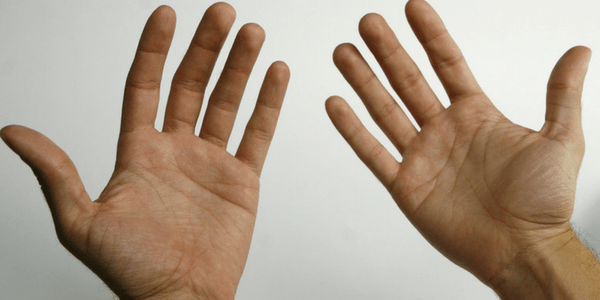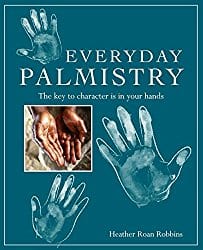
 Everyday Palmistry: The Key to Character is in Your Hands, by Heather Roan Robbins
Everyday Palmistry: The Key to Character is in Your Hands, by Heather Roan Robbins
Cico Books, 978-1782493730, 128 pp., 2016
Palmistry is many people’s first glimpse into divination. It’s no wonder because all you really need is a set of eyes and some knowledge to get started. Everyday Palmistry: The Key to Character is in Your Hands by Heather Roan Robbins is a solid resource for getting started on the wide world of palmistry.
This book is targeted at beginners. It’s a thin volume of only 128 pages, but it’s surprisingly full of information that is easy to follow and provides a great deal of support in the way of images, easy navigating and full descriptions.
This is not a workbook; there are no exercises. People hoping to learn are encouraged to view their own hands first and foremost, but also to check out others. To this end, the book is full of colour illustrations and photos of physical hands, both famous and unknown. Each of these photos are accompanied by an explanation of how that particular hand would be read. For example, in the section regarding various mounds (parts of the palm) there is a description along with the stock photo of how that palm would be read.
Everyday Palmistry is broken into three parts. The first part outlines the major shape and area of the hand. The palm, fingers, and overall combined shape. The second part dives into the various lines that appear on the hand, both major and minor. The third section is the shortest and deals with how to put everything together to create a reading.
This book really shines in the first and second parts. The variety of pictures it provides gives ample visual information on the different lines, shapes, breaks, and types of hands there are. There is a ton of diversity in age, race, and gender in the photos used. These, with the well written instructions, allow even brand new readers to gain rapid understanding of the ways that the various parts of the hand work together to form a full understanding of the person.
I cannot stress enough how much the full colour photographs and sketches in the book helped to clarify the subtle differences and various types of connections that can be found on hands. In the second section where Robbins covers lines, each variation of that line is illustrated clearly so that those subtle differences between a broken or chained line, for example, can be plainly seen.
Another strength of this book is how it deals with the more negative connotations certain lines and appearances on a hand could have. It is very nonjudgmental and provides ways to bring balance into the lives of people that are affected by such readings.
The way that this book is written is very easy to follow. I especially appreciated that when Robbins makes mention of a part of the hand that wasn’t the main focus of the current section, the page numbers where further information could be found were included. This is great for people who do not wish to follow the book straight through, or who learn in a different manner.
In fact, after spending some time with this book, I was able to take the knowledge and do some minor palm reading right away, without looking back at the text. The way it is presented is very easy to remember and practical.
As much as I felt that this book was solid, there is one caveat. Robbins has a non-traditional practice and switches the Sun and Venus mounds to better suit her own understanding of palmistry and astrology. Although I do agree that this reading does work better and is more intuitive — especially if you have a background in astrology — it may cause confusion as readers branch out to other, denser texts.
Despite this, I don’t think that this change is anywhere close to enough reason to discount this text. Robbins is upfront about her changes and warns new readers that they should keep her changes in mind as they continue their journey into palmistry if they decide to go further than this book.
The book is written in a very approachable style. The descriptions included are thorough and easy to follow. Overall, the layout of the text was well done. Perhaps it would have been just a bit easier to read if the sub-sections were broken up a bit more, space-wise. For example, when discussing the fate line, each variation and the suggestions to bring balance to them are all in one section. I would have liked it better if that section had spaces between each one, for readability.
Overall, Everyday Palmistry is a great book. It is not an exhaustive resource by any stretch of the imagination, but it does provide a solid foundation for exploring palmistry for anyone who is curious about this craft.
Image credit: Nate Steiner








